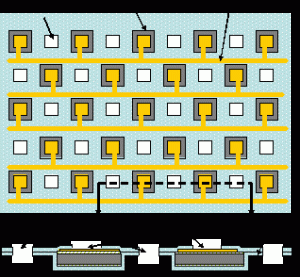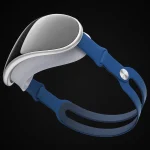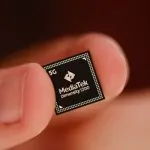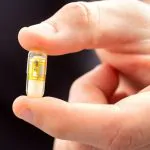The following text is taken from the research work from R. B. Katragadda and Y. Xu, “A Novel Intelligent Textile Technology Based on Silicon Flexible Skinsâ€, Proceeding of the International symposium on wearable computer 2005 (ISWC05), Osaka, Japan, Oct. 18-21, 2005.
It shows a very interesting way on how to integrate complex electronic elements and function into fabrics. It is based on the idea to do the production of electronic components to a large extend in the for the electronic industry used processes but merge those conventional processes with the fabric and clothing specific requirements.
– begin quote:
Intelligent textiles, variously known as smart fabrics, electronic textiles, or e-textiles, have attracted considerable attentions worldwide due to their potential to bring revolutionary impacts on human life. Despite many promising progresses in this exciting newly emerged research field, there still exist a number of important obstacles. One of the most challenging issues is the conflict between the flexibility of the textiles and the need to incorporate sensing and computation modules. To address this critical issue, an innovative intelligent textile technology is proposed. The central hypothesis is that practical intelligent textiles can be realized by integrating fabrics with flexible transducers/electronics that are made using a unique, ‘flexible-skin’ technology.
The unique features of the silicon-based flexible skins are extremely desirable for intelligent textiles. A novel approach of making intelligent textiles by integrating the silicon-based flexible skins with textiles is proposed. The most important advantage of this novel technology is its compatibility with current MEMS and IC technologies, since MEMS devices (micromachined transducers) and ICs can be fabricated on the silicon wafer before the formation of the skin. This not only saves significant R&D efforts by avoiding re-invention, but also enables the integration of abundant sensing and computational capabilities offered by the silicon-based technology.

figure 1
In order to be integrated with textiles, the original flexible skins are modified and a new perforated structure is proposed as schematically shown in Fig. 1. The new flexible skin consists of 4 components: (1) silicon islands that host sensors, electronics, and bonding pads; (2) metal interconnect wires between silicon islands; (3) polymer layers that sandwich silicon islands and metal wires; and (4) stitching holes etched through polymer layers, which allow the direct sewing into fabrics. One of the fabricated silicon flexible skins is shown in Fig. 2 (a). It can be easily twisted and bent without breaking the interconnect traces and silicon islands as shown in Fig 2 (b)

The flexible transducers/circuits made by the proposed method can be directly embroidered into textiles. It is worth noting that the stitching methods and patterns have substantial impact on the mechanical properties and robustness of the assembled fabrics. Numerous stitching patterns and methods, which have already been developed in the textile industry, will be an excellent resource to exploit. The following picture shows one skin stitched onto the surface of textiles using conductive yarns. The electrical contact was made by conductive epoxy.

– end quote
Following the proposed principles from R. B. Katragadda and Y. Xu would allow the use of rather conventional methods and processes to create truly Smart Textiles.
Please follow this link to read to full article.





















